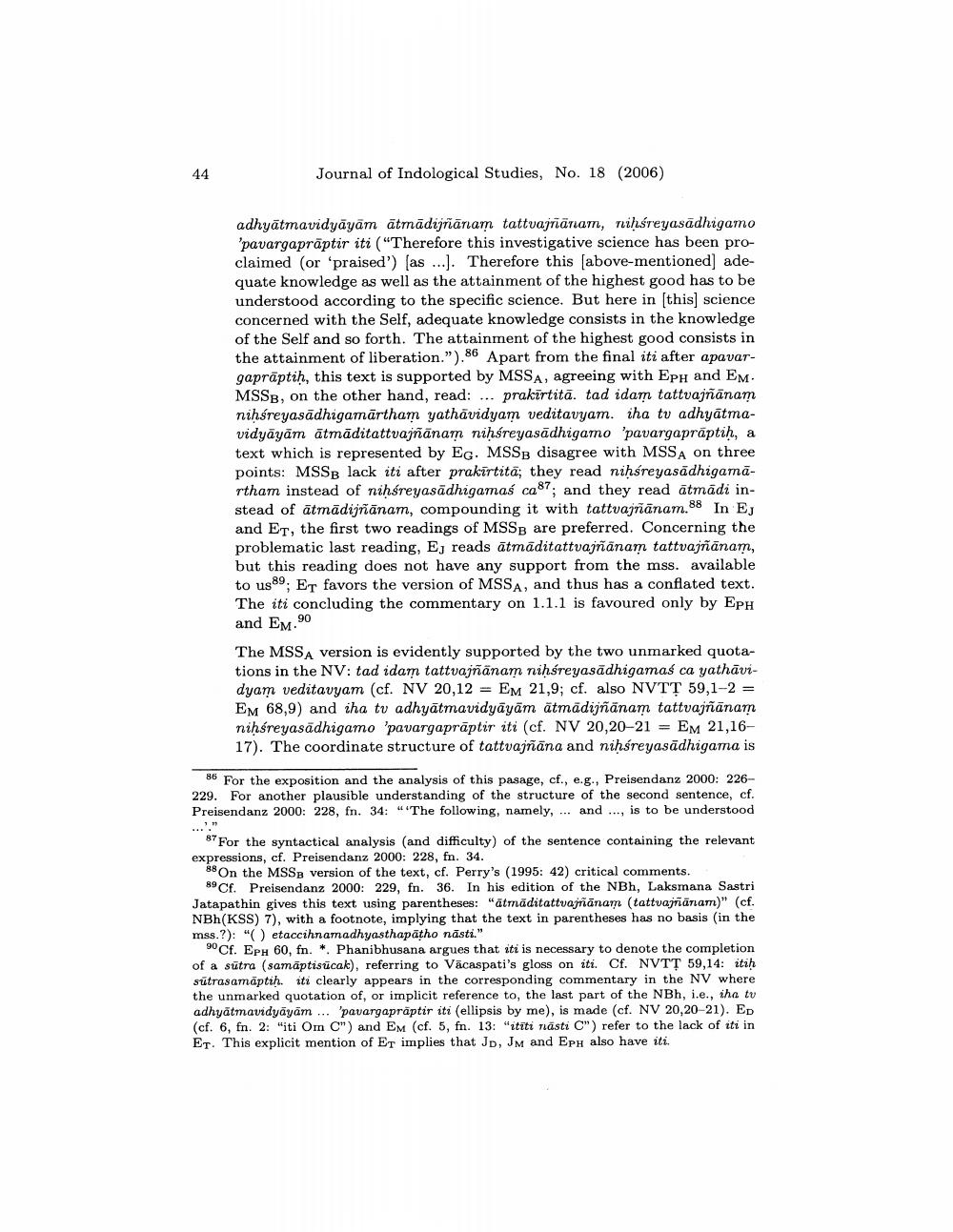________________
Journal of Indological Studies, No. 18 (2006)
adhyātmavidyāyām ātmādijriānam tattvajriānam, nihśreyasādhigamo 'pavargaprāptir iti ("Therefore this investigative science has been proclaimed (or 'praised') (as ...). Therefore this (above-mentioned) adequate knowledge as well as the attainment of the highest good has to be understood according to the specific science. But here in this science concerned with the Self, adequate knowledge consists in the knowledge of the Self and so forth. The attainment of the highest good consists in the attainment of liberation.").86 Apart from the final iti after apavargaprāptih, this text is supported by MSSA, agreeing with Eph and EM MSSB, on the other hand, read: ... prakirtitā. tad idam tattvajñānam nihśreyasādhigamartham yathāvidyam veditavyam. iha tv adhyatmavidyāyām ātmäditattvajñānam nihśreyasādhigamo 'pavargapräptih, a text which is represented by EG MSSB disagree with MSSA on three points: MSSB lack iti after prakirtitā; they read nihśreyasādhigamartham instead of nihśreyasādhigamas ca®; and they read ātmādi instead of ātmādijñānam, compounding it with tattvajñiānam.88 In EJ and ET, the first two readings of MSSB are preferred. Concerning the problematic last reading, Ej reads ātmaditattvamanam tattvajñanam, but this reading does not have any support from the mss. available to us89, ET favors the version of MSSA, and thus has a conflated text. The iti concluding the commentary on 1.1.1 is favoured only by Eph and EM.90
The MSSA version is evidently supported by the two unmarked quotations in the NV: tad idam tattvajñānam nihśreyasādhigamaś ca yathāvidyam veditavyam (cf. NV 20,12 = EM 21,9; cf. also NVTT 59,1-2 = EM 68,9) and iha tv adhyatmavidyāyām ātmādijñānam tattvajñanam nihśreyasādhigamo 'pavargaprāptir iti (cf. NV 20,20-21 - EM 21,1617). The coordinate structure of tattvajñāna and nihśreyasādhigama is
86 For the exposition and the analysis of this pasage, cf., e.g., Preisendanz 2000: 226229. For another plausible understanding of the structure of the second sentence, cf. Preisendanz 2000: 228, fn. 34: “The following, namely, ... and ..., is to be understood
...."
87 For the syntactical analysis and difficulty) of the sentence containing the relevant expressions, cf. Preisendanz 2000: 228, fn. 34.
88 On the MSSB version of the text, cf. Perry's (1995: 42) critical comments.
89 Cf. Preisendanz 2000: 229, fn. 36. In his edition of the NBh, Laksmana Sastri Jatapathin gives this text using parentheses: "atmaditattuajānam (tattvajriānam)" (cf. NBh(KSS) 7), with a footnote, implying that the text in parentheses has no basis in the mss.?): "O etaccihnamadhyasthapatho năsti."
90Cf. EPH 60, fn. *. Phanibhusana argues that it is necessary to denote the completion of a sutra (samāptisücak), referring to Vācaspati's gloss on iti. Cf. NVTT 59,14: itin sütrasamäptih. iti clearly appears in the corresponding commentary in the NV where the unmarked quotation of, or implicit reference to, the last part of the NBh, i.e., iha tu adhyatmavidyāyām ... 'pavargaprāptir iti (ellipsis by me), is made (cf. NV 20,20-21). ED (cf. 6, n. 2: "ti Omn 0") and Em (cf. 5, fn. 13: "ititi rasti C") refer to the lack of iti in Et. This explicit mention of Er implies that JD, JM and EpH also have iti.




